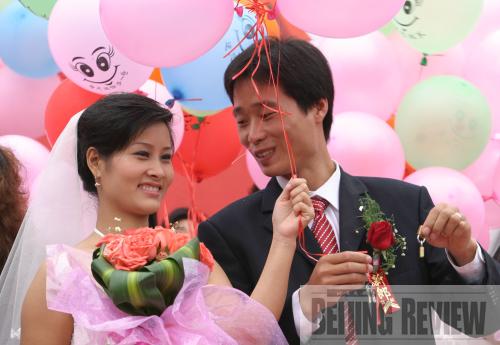|
 |
|
TOGETHER FOREVER: The Chinese General Social Survey Report found that nearly 70 percent of respondents were satisfied with their marriages. The photo shows a couple at their wedding ceremony (XINHUA) |
It is an indisputable fact that the Chinese economy has been booming over the last five years, boasting brisk annual growth averaging around 10 percent a year. But how does that growth affect China's social structure? Have Chinese people, rural and urban residents, felt a boost to their quality of life?
Scholars from Renmin University of China's National Survey Research Center (NSRC) believe they know the answers to these questions and have presented research to support their conclusions.
In May, the Chinese General Social Survey Report (2003-08), based on questionnaire surveys of more than 40,000 urban and rural households in 28 provinces, autonomous regions and municipalities, was launched in Beijing. All respondents were over the age of 16. The report has revealed changes to respondents' economic standings, employment situations, population mobility, living conditions, lifestyles and behaviors, according to the NSRC.
Education
According to the Beijing-based Guangming Daily, the survey shows that China's youth have been attaining higher levels of education compared with their parents and grandparents. In another positive sign, females have been subject to less inequality in receiving education over the last 50 years.
The survey reports that 60.6 percent of people born between 1937 and 1946 received a primary school education or below while only 17.4 percent made it to senior middle school or above. Of those born between 1977 and 1988, on the other hand, less than 10 percent stopped going to school at the primary level or below while 58.8 percent attained a senior middle school education or higher.
In terms of education gender equality, males went to school an average of 1.8 years longer than females among respondents 60 years old and above. Among the population born between 1977 and 1988, the gap shrank to 0.3 years and women have surpassed men in attendance at junior colleges in the age group.
The report says that despite increased educational opportunities, the average time people spend in school in most parts of China is less than 12 years, far below that seen in most industrialized countries.
Employment
The survey found that 64.6 percent of all respondents were employed and 25.6 percent at one time held a job but were currently unemployed. Of the urban respondents, 49.8 percent were employed and 38.8 percent were currently unemployed.
The age at which people get their first job has been increasing since 1949, the employment survey also found. The average age that respondents got their first job has edged up from 18 in the mid-1960s to 21.3 now.
| 